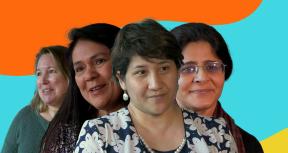The World Bank Group has embarked on an ambitious Evolution Roadmap to reform itself, working on both the aims of development and on how they are achieved, as it strives to become a bigger and better bank.
This is a critical point in history, and the global context facing development is full of challenges.
But, as we face these challenges, we can learn from the past. The last time the Bank Group did a comparable strategy exercise was with the Forward Look in 2016 and the capital increase package in 2018.
The roadmap aims to increase work on pandemics, fragile and conflict-affected situations, climate change, and other crises. This builds on the experiences and successes of the past few decades, which the Forward Look and the capital increase package converted into strategies for greater impetus.
The roadmap also picks up on some unfinished business: It proposes a greater focus on some areas where the International Bank for Reconstruction and Development (IBRD) and the International Finance Corporation (IFC) did not fully deliver on the priorities of the Forward Look and Capital Increase Package. These include boosting private capital and domestic resource mobilization, changing the approach to knowledge, and improving internal organizational effectiveness.
The Independent Evaluation Group (IEG) recently reviewed the implementation and results of the 2018 capital increase package. Based on this, we offer four lessons for the roadmap as follows:
When the Bank Group puts its weight behind a priority, its goals can be achieved.
The Bank Group delivered on many corporate commitments after the 2018 capital increase, even if it did not achieve all its targets and objectives. Putting its full weight behind an objective requires large and sustained efforts. These include establishing corporate strategies and dedicating an internal unit or other organizational arrangement to ensure follow-through, as well as collaboration, incentives, indicators, targets, reporting, and so on.
IEG’s review of the capital increase package shows that the Bank Group made the most progress on priorities with senior leadership buy-in, clear strategies, indicators for success, and realistic targets. The Bank Group made the least progress when the priorities lacked clear policy measures, strategies, and measurable indicators, or had limited oversight, weak collaboration, inadequate incentives, and overly ambitious targets. See figure below.
Quality of Capital Increase Package Implementation and Reporting across Capital Increase Package Clusters
The Bank Group’s capabilities are impressive, but it cannot succeed in everything.
It is not realistic to put the organization’s full weight behind too many priorities at a time. All development challenges are important but some must be prioritized by our organization to tackle and for senior leadership to engage on. These can then be supported with strategies, action plans, indicators, and board reporting. The Bank Group and its shareholders must confront tradeoffs and seek buy-in to focus on fewer areas and deepen its knowledge, partnerships, convening, and impact in those areas.
The Bank Group sometimes does change management in a discontinuous manner.
There has been a tendency to launch big initiatives that then slowly fade and reappear in new guises some years later. This is what occurred with initiatives such as Agile Bank, the People Strategy, and the Knowledge Bank, as well as with the efforts to boost collaboration among the World Bank, IFC, and the Multilateral Investment Guarantee Agency.
IEG’s evaluation Knowledge Flow and Collaboration Under the World Bank’s New Operating Model, which assesses the World Bank’s 2014 reforms, also concludes that there is a need to ensure more continuity in change management efforts. It finds that “the central change management team in charge of designing the reforms was dispersed during implementation and not replaced. . . . there was no leadership that could focus on organizational effectiveness, ensure continuity in change management, and help business units navigate the complex changes under way. Reform proposals to deepen support, metrics, incentives, and leadership for knowledge and collaboration were not implemented”.
The lesson on ensuring more continuity in change management efforts remains relevant. This could be achieved by collecting and reviewing data on organizational effectiveness and learning from past reforms and other organizations.
Measuring Bank Group outcomes is challenging.
Much of the Bank Group’s results measurement and reporting focuses on inputs and outputs, not outcomes, and is geared toward showing our shareholders how we progress to targets. Corporate indicators, such as those on gender and climate, are often blunt tools that help foster accountability and ensure sustained implementation but do not really help us understand outcomes or learn and adapt our projects, programs, and strategies.
The Bank Group could tap into their data-rich project monitoring and evaluation systems to develop metrics and assessments that better capture ongoing and ex post results. The Bank Group could also combine indicator-based reporting with periodic deep dives that focus on outcomes.
See also our previous blog Lessons for the World Bank Group’s Evolution from the 2018 Capital Increase Package and the full validation report The World Bank Group’s 2018 Capital Increase Package: An Independent Validation of Implementation and Results.










Add new comment